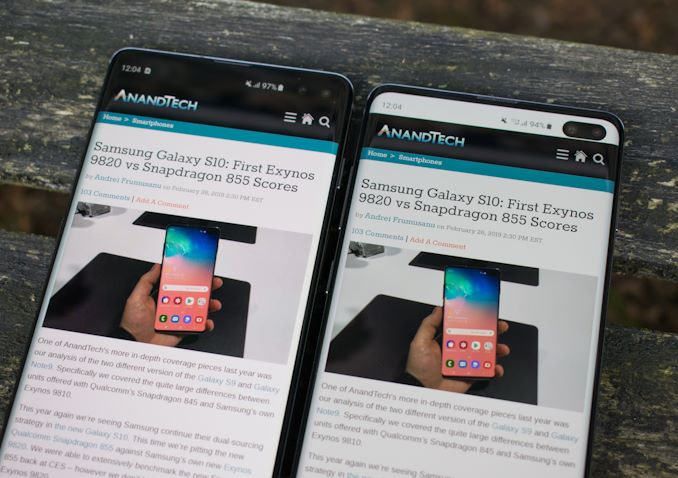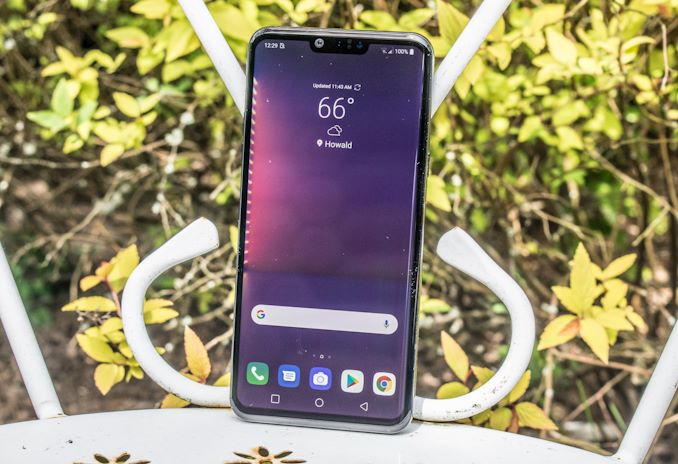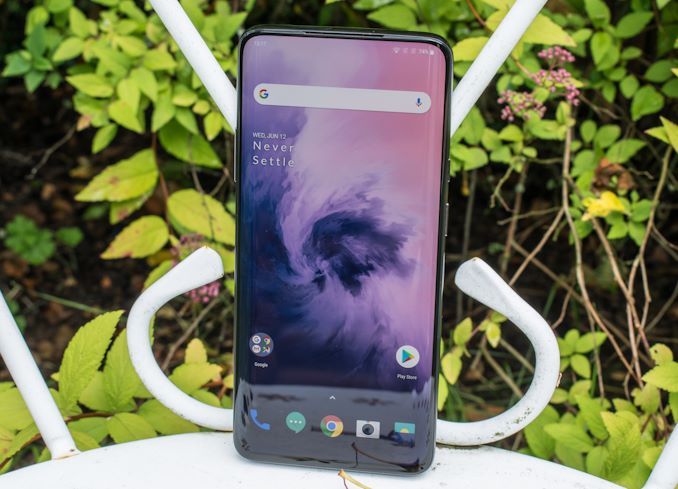The Snapdragon 855 Phone Roundup: Searching for the Best Implementations
by Andrei Frumusanu on September 5, 2019 8:30 AM ESTTop Devices - The Well Knowns
First of all we’ll be going over a brief overview of the various devices, covering their unique aspects and what makes them stand out from the competition.
Samsung Galaxy S10+
Starting off with the Galaxy S10+, the device should really need no introduction. Samsung was among the first vendors to actually employ the Snapdragon 855 this year, and to date has been able to be one of the, if not the most, successful Android devices of the year. The Galaxy S10 is characterized by its new design language with a edge-to-edge screen which includes the much discussed camera cut-out. Further features which mark the Galaxy S10 is the triple-camera setup which includes normal wide-angle, telephoto and ultra-wide-angle lenses which were the top camera performers of this year – at least till time of writing.
Samsung also manage to be exceptionally power efficient this year. The inclusion of a 4100mAh battery was a boon, however Samsung’s very power efficient screen employed in the phone was able to put it ahead of other Android devices when it comes to battery longevity.
The company continues to use a dual-sourcing strategy, using both Qualcomm’s as well as Samsung LSI’s own Exynos chipsets in the same phone. We don’t really know why Samsung does this, as sometimes it can very much dilute R&D efforts to create the same phone with two hardware platforms. The benefit here is that we’re able to have an apples-to-apples comparison device and directly comparing Qualcomm’s Snapdragon SoCs against Samsung’s Exynos chip. This year, the Qualcomm variant yet again managed to be the superior device, delivering an almost flawless experience while the Exynos variant had some rough edges here and there in terms of performance or camera experience.
Read Our Galaxy S10+ Full Review Here
LG G8 ThinQ
LG had also been among the earlier adopters of the Snapdragon 855 in the new LG G8. This year LG was able to greatly improve on the hardware experience compared to the G7 last year. The G8 is also the first in LG’s G-series to come with an OLED screen whereas all previous generations were still using LCDs. LG still has issues with its own OLED panel production as we’ve seen rather lackluster panel power efficiency compared to Samsung or even BOE, of which the G8 also suffers from, ending up with average battery life.
The G8’s camera this year was much improved, and in particular daylight quality was a strength of the phone. LG oddly opted to deliver the G8 with only two camera modules in western markets, the main camera sensor and the wide-angle, reserving the triple-camera variant with the added telephoto module to Korean domestic markets.
Other specialties of the G8 include a new under-screen piezoelectric speaker under the top screen, replacing the traditional earpiece speaker. To date this has been the best implementation of its kind in terms of audio quality, with the new unit being used a stereo speaker. One attempt to differentiate the G8 from other devices was the introduction of a time-of-flight sensor which enabled Minority Report-like gestures to control the phone. Unfortunately I found these to be rather gimmick and offer very little added experience in daily usage of the phone.
Read Our LG G8 Full Review Here
OnePlus 7 Pro
Another popular Snapdragon 855 device this year was the OnePlus 7 Pro. This year marked the first time that OnePlus delivered two device tiers at the same time, putting the 7 Pro a tier higher than the regular new OnePlus 7. The company’s rationale here is that as it matured it’s able to offer more refined experiences and hardware, which in turn come at a higher price point.
The 7 Pro’s key characteristic is its screen, in particular two unique aspects of it. First of all, it’s a bezel-less design without any kind of notch or cut-out, offering a true full-screen experience which gives the phone a very modern look that stands out compared to other 2019 devices. The front-camera is implemented via a mechanical slide-out mechanism at the top of the phone, which is one way of delivering on the bezel-less screen experience.
The other key aspect of the phone is the fact that it’s using a 1440p 90Hz OLED screen – which to date is still unique. The 90Hz experience is in particular something that makes the phone stand out and the single most important key feature of the phone that would want one to use the OnePlus 7 Pro.
Weaknesses of the 7 Pro include the fact that it’s quite the big and hefty device, likely thanks to the internal front-camera sliding mechanism. While OnePlus implemented the 90Hz display in the best way possible, it still comes at a cost to battery life, so even though the phone has a 4000mAh battery, its battery life is relatively in the middle of the pack. Further disappointments were found in the camera department which I blame on lackluster post-processing as well as weakness of the camera sensor.
Read Our OnePlus 7 Pro Full Review Here
Sony Xperia 1
The Sony Xperia 1 was the first Sony device we’ve been able to review here at AnandTech. The phone marks a new start for Sony’s mobile division following an internal reorganization and a few years of lackluster sales.
In terms of design language, the new Xperia 1 is certainly a unique device thanks to its 21:9 screen aspect ratio which I’ve found to offer a great experience. The screen is also the phone’s weakness, as Sony’s decision to go for a 4K panel resolution makes very little sense in practice. Yes, it’s the sharpest screen in the market and the uniformity is quite incredible, however the difference to a 1440p screen is just not noticeable enough. Keep in mind this is coming from somebody who deems 1080p screens in smartphones as being insufficient as I can easily see the pixel matrix. The big negative for the phone is found in its battery life, as the meager battery capacity combined with a power hungry screen makes for some quite disappointing results.
Cameras on the Xperia 1 were also a double-edged sword. On one hand Sony managed to get one of the sharpest and most detailed shots in the market, but at the same time the phone suffered from a bad handling of dynamic range and HDR processing, as well as lacklustre low-light performance.














47 Comments
View All Comments
cha0z_ - Monday, September 9, 2019 - link
Actually the exynos is more EXPENSIVE! Note 9 when released costed 1100 euros in Europe vs 1000 dollars in US, you can check the conversion yourself as 1000 euros are over 1100 dollars. The fact you got a samsung device for cheaper is nothing exclusive to you nor China - there are super big discounts in US too for the qualcomm variants.s.yu - Monday, September 9, 2019 - link
Actually I look before I buy, the SK version is the cheapest anywhere, I had the option of buying the HK version(on SD) of the same tier for ~$100 more but I decided against it thinking it's not worth the premium.A friend in the US also bought a Note 8 at the time and went for an HK version because getting it from HK is still cheaper than in the US and he preferred SD. I don't know how there are significant discounts in the US but suspect they're bound by contracts.
As for the high price in Europe that should come as a surprise to no one. Most electronics are more expensive in Europe, it's not specific to Samsung.
1nterceptor - Tuesday, September 10, 2019 - link
I agree, would be really great if we could see exy9825 vs exy 9820 vs sd855+ vs sd855. Why exy9820 and sd855 you may ask, well because of the software updates, i wonder if and how much difference does it make now after 6 months on the market and couple of firmware updates...1nterceptor - Tuesday, September 10, 2019 - link
...although, i believe exy9825 is not by any means much faster/better than the "old" 9820, it is probbably more efficient on the other hand...jrocket - Thursday, September 5, 2019 - link
Since many of these phones vary in price significantly, it would be interesting to see a "performance per dollar" value comparison.IUU - Friday, September 6, 2019 - link
Would be if it was not so trivial. I mean , if one phone costs 400 dollars and another one 800, there you have straight away your performance per dollar. All are sd 855s , so there is nothing more to consider. One could argue about camera, screen, battery life, but these are irrelevant to performance.flyingpants265 - Tuesday, September 17, 2019 - link
It says right in the article that the performance differs depending on software implementation.Wardrive86 - Thursday, September 5, 2019 - link
Excellent article as always! I would like to see which version of Android each phone has in the system performance tests to see if some of the older device performance data is up to date and also see which Opengl and Vulkan drivers each device has while testing was done...however even without that data still the best tech site there is. Thanks!Wardrive86 - Sunday, September 8, 2019 - link
For example:LG G7 Android 9 opengl driver : 331.0
Slingshot Extreme Unlimited OpenGL ES 3.1
Physics peak : 3486
Physics sustained : 3392
Graphics peak : 5467
Graphics sustained: 5326
(5 runs, 20 minutes, Room temp: 78F/25.6C)
Immediately followed by Work 2.0
Performance : 8146
Web : 6588
Video : 5701
Writing. : 9554
Photo : 15830
Data : 6314
yacoub35 - Thursday, September 5, 2019 - link
Aside from battery life, the things I would care most about in a phone comparison are:Does it have stereo speakers?
Does it have a headphone jack?
Does it use vanilla Android (or how close to vanilla is what it uses)?
Does it get all of the Android updates and security patches in a timely fashion?
How is the camera performance (speed to load the app and take a photo, image stabilization, low light performance)?
How much RAM does it have?
How much internal storage (excluding the OS) and how much expandable, if any?